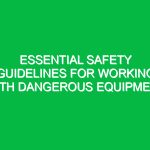Welcome and Purpose of the Toolbox Talk
Good morning team! Thank you for gathering here today for our Toolbox Talk. Today, we’ll be discussing an important topic that can significantly impact our health, safety, and Environment (HSE) practices: taking shortcuts. While we all strive to be efficient and get our tasks done quickly, it’s crucial to understand that shortcuts can lead to serious risks and Hazards. Our goal today is to explore the implications of taking shortcuts, share Best Practices, and ensure that we all contribute to a safer working environment.
Understanding Taking Shortcuts in HSE
In the context of HSE, taking shortcuts refers to the practice of bypassing established Safety protocols, procedures, or Standards in order to complete tasks more quickly. While the intention behind taking shortcuts may stem from a desire to save time or effort, the consequences can be dire, including increased risk of accidents, injuries, or even fatalities.
Real-Life Example of Taking Shortcuts
Let’s consider a hypothetical scenario. Imagine a construction worker tasked with rigging a heavy load. Instead of using the proper lifting equipment and following the Safety Procedures outlined in our Training, the worker decides to use a makeshift method, thinking it will save time. Unfortunately, this decision leads to the load falling, resulting in injury to the worker and bystanders. This incident underscores the importance of adhering to safety protocols and avoiding shortcuts.
The Importance of Following Safety Protocols
When we take shortcuts, we often overlook critical Safety Measures that are put in place to protect us. Here are a few reasons why following established protocols is essential:
- Prevention of Accidents: Safety protocols are designed to minimize risks. By following them, we reduce the likelihood of accidents occurring.
- Legal Compliance: Many safety Regulations are mandated by law. Non-compliance can result in legal repercussions for both individuals and the company.
- Protecting Lives: Ultimately, the goal of HSE practices is to protect lives. Every worker has a right to a safe working environment.
Identifying Hazards and Risks of Taking Shortcuts
Taking shortcuts can expose us to various hazards. Here are some common risks associated with this practice:
- Physical Hazards: Skipping Safety Gear or procedures can lead to physical injuries from equipment or environmental factors.
- Health Hazards: Ignoring safety protocols can expose workers to harmful substances or environments, increasing the risk of long-term health issues.
- Environmental Risks: Shortcuts can also lead to environmental harm, such as spills or contamination, which can have far-reaching Effects on our surroundings.
Best Practices to Avoid Taking Shortcuts
To foster a culture of safety, it’s vital to adopt Best Practices that discourage taking shortcuts:
- Always Use Proper Safety Equipment: Ensure that you have and use the necessary Personal Protective Equipment (PPE) at all times.
- Follow Established Procedures: Adhere to the safety protocols and standard operating procedures set forth by our organization.
- Communicate and Report: If you notice someone taking shortcuts or if you feel a procedure is unsafe, speak up! Communication is key in maintaining safety.
- Seek Clarification: If you’re unclear about a procedure, ask for guidance rather than improvising.
- Prioritize Safety Over Speed: Remember, it’s better to take the time to do things correctly than to rush and risk safety.
Engaging with Team Members: Open Discussion
Now that we’ve covered the risks and best practices associated with taking shortcuts, I’d like to open the floor for discussion. Here are a few questions to consider:
- Can anyone share a time when taking a shortcut led to a negative outcome?
- What strategies do you use to ensure safety in your daily tasks?
- How can we better support each other in avoiding shortcuts on the job?
Regulations and Standards Related to Taking Shortcuts
It’s essential to understand the regulations and standards that govern our industry regarding HSE practices. Organizations such as OSHA (Occupational Safety and Health Administration) have established guidelines that must be followed to ensure Workplace Safety. Non-compliance with these standards not only jeopardizes safety but can also lead to severe penalties for our company.
In addition to legal obligations, our company has its own policies that reflect our commitment to safety. Familiarize yourself with these policies and understand that they are in place to protect you and your coworkers.
Conclusion: Commitment to Safety
In conclusion, taking shortcuts might seem like an attractive option in the moment, but the risks far outweigh any perceived Benefits. By committing to follow safety protocols, using the appropriate equipment, and prioritizing communication, we can create a safer work environment for everyone.
Thank you all for your attention and for participating in today’s Toolbox Talk. Let’s keep looking out for one another and ensure we all go home safely at the end of the day. Remember, safety is our shared responsibility, and together we can prevent accidents caused by taking shortcuts.


